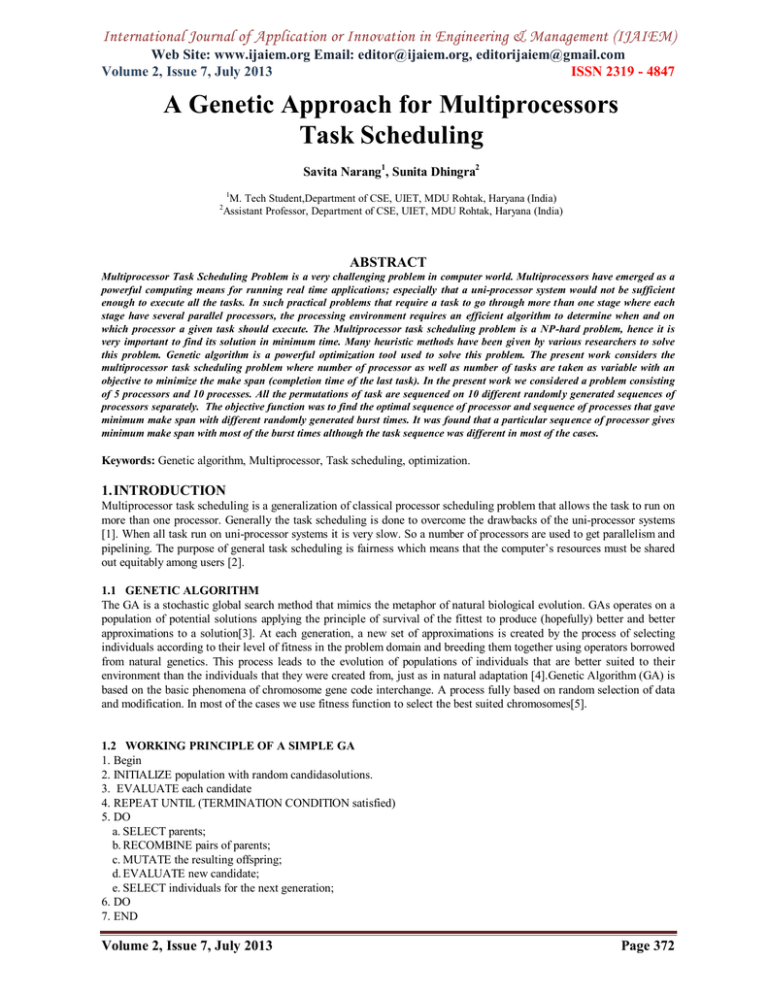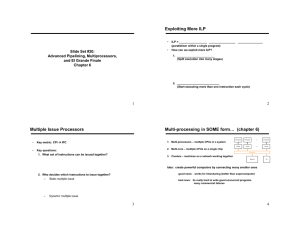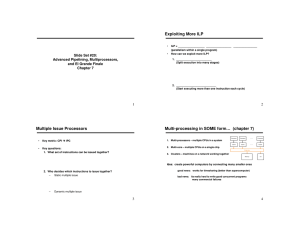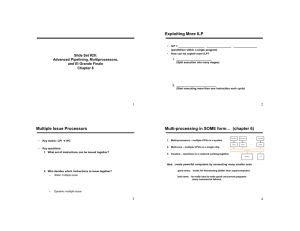A Genetic Approach for Multiprocessors Task Scheduling Web Site: www.ijaiem.org Email: ,
advertisement

International Journal of Application or Innovation in Engineering & Management (IJAIEM)
Web Site: www.ijaiem.org Email: editor@ijaiem.org, editorijaiem@gmail.com
Volume 2, Issue 7, July 2013
ISSN 2319 - 4847
A Genetic Approach for Multiprocessors
Task Scheduling
Savita Narang1, Sunita Dhingra2
2
1
M. Tech Student,Department of CSE, UIET, MDU Rohtak, Haryana (India)
Assistant Professor, Department of CSE, UIET, MDU Rohtak, Haryana (India)
ABSTRACT
Multiprocessor Task Scheduling Problem is a very challenging problem in computer world. Multiprocessors have emerged as a
powerful computing means for running real time applications; especially that a uni-processor system would not be sufficient
enough to execute all the tasks. In such practical problems that require a task to go through more than one stage where each
stage have several parallel processors, the processing environment requires an efficient algorithm to determine when and on
which processor a given task should execute. The Multiprocessor task scheduling problem is a NP-hard problem, hence it is
very important to find its solution in minimum time. Many heuristic methods have been given by various researchers to solve
this problem. Genetic algorithm is a powerful optimization tool used to solve this problem. The present work considers the
multiprocessor task scheduling problem where number of processor as well as number of tasks are taken as variable with an
objective to minimize the make span (completion time of the last task). In the present work we considered a problem consisting
of 5 processors and 10 processes. All the permutations of task are sequenced on 10 different randomly generated sequences of
processors separately. The objective function was to find the optimal sequence of processor and sequence of processes that gave
minimum make span with different randomly generated burst times. It was found that a particular sequence of processor gives
minimum make span with most of the burst times although the task sequence was different in most of the cases.
Keywords: Genetic algorithm, Multiprocessor, Task scheduling, optimization.
1. INTRODUCTION
Multiprocessor task scheduling is a generalization of classical processor scheduling problem that allows the task to run on
more than one processor. Generally the task scheduling is done to overcome the drawbacks of the uni-processor systems
[1]. When all task run on uni-processor systems it is very slow. So a number of processors are used to get parallelism and
pipelining. The purpose of general task scheduling is fairness which means that the computer’s resources must be shared
out equitably among users [2].
1.1 GENETIC ALGORITHM
The GA is a stochastic global search method that mimics the metaphor of natural biological evolution. GAs operates on a
population of potential solutions applying the principle of survival of the fittest to produce (hopefully) better and better
approximations to a solution[3]. At each generation, a new set of approximations is created by the process of selecting
individuals according to their level of fitness in the problem domain and breeding them together using operators borrowed
from natural genetics. This process leads to the evolution of populations of individuals that are better suited to their
environment than the individuals that they were created from, just as in natural adaptation [4].Genetic Algorithm (GA) is
based on the basic phenomena of chromosome gene code interchange. A process fully based on random selection of data
and modification. In most of the cases we use fitness function to select the best suited chromosomes[5].
1.2 WORKING PRINCIPLE OF A SIMPLE GA
1. Begin
2. INITIALIZE population with random candidasolutions.
3. EVALUATE each candidate
4. REPEAT UNTIL (TERMINATION CONDITION satisfied)
5. DO
a. SELECT parents;
b. RECOMBINE pairs of parents;
c. MUTATE the resulting offspring;
d. EVALUATE new candidate;
e. SELECT individuals for the next generation;
6. DO
7. END
Volume 2, Issue 7, July 2013
Page 372
International Journal of Application or Innovation in Engineering & Management (IJAIEM)
Web Site: www.ijaiem.org Email: editor@ijaiem.org, editorijaiem@gmail.com
Volume 2, Issue 7, July 2013
ISSN 2319 - 4847
In genetic algorithm we initialize the population by some sequence of tasks or schedules these are called chromosomes.
From this population we select the best fit schedules and apply GA operators on them called crossover and mutation. The
offsprings produced as a result of this are evaluated for their fitness and suitable offsprings are added to the population
list. In this way after every generation we get a population more suited to the fitness function. When we get a schedule
having a minimum makespanstoping criteria is met and GA stops[6]
2. PROPOSED WORK
The work deals with the multiprocessor task scheduling problem(MPTS) where number of processors as well as number
of processes both are taken as variable. The work is based on the deterministic model i.e. the number of processors
execution of task on different processors is known in advance. In addition to it , the communication cost between two task
is considered to be negligible and the multiprocessor system is non-pre-emptive. The processors are homogeneous and
each processor completes the current task before the new one starts its execution. The assumptions for the MPTS are
given below:
2.1 Assumptions:
1. Processors are kept homogeneous.
2. No pre-emption is allowed.
3. All the jobs and machines are available at time Zero.
4. Machines never break down.
5. The processing time of each task on all the machine are known.
6. Each machine is continuously available for assignment.
7. The first machine is assumed to be ready whichever and whatever job is to be processed on it first.
8. Processors may remain idle.
9. Task cannot be cancelled or broken down into smaller tasks.
The present work is the special case of multiprocessor task scheduling in which the processes and processors both are
taken as a variable and our goal is to get an optimal schedule for the n tasks on m processors.
2.2 Problem Statement
In multiprocessor task scheduling, there are n number of processes denoted as Ji , where i=1,2,.. n, that are to be
processed on m processors denoted as Mk, where k= 1,2,..,m. Number of processors as well as number of processes both
are taken as variable. Operation of ith process on kth processor will be denoted by Oki with the processing time Pki.
Operation sequence is same for all the processes on all the processors.
We are to find a sequence of the processes on a sequence of processor that give minimum makespan.Once a machine
starts to process a job, no interruption is allowed. The time required for all operations to complete their processes is
called make span. Our intention is to minimize this makespan value. All the jobs and machines are available at time Zero.
2.3 Methodology:
We have generated 10 random permutation sequences of processors. These processor sequences were fixed in a processor
sequence list(PL). We selected processor sequences one by one from the PL and applied the following procedure on each
sequence. We took a randomly generated processing time pki for task i and processor k. Picked one processor sequence
from the PL x1 , x2 , x3 ,....xm. . Different permutations of n tasks (j=1, 2, 3 , ...n) are sequenced through these m
processors x1 , x2 , x3 ,....xm. Then the problem was to find best sequence of task for the given sequence of processor.
Given the processing time pki for task i and processor k , and a task permutationπ1, π2, π3 ....πn and a processor
permutation x1 , x2 , x3 ,....xm.where n tasks (j=1, 2, 3 , ...n) are sequenced through m processors(k=1, 2, 3 , ...m) using
the same permutations. The completion time C(xk, πi) for ith task of the given permutation π and the kth processor of
the given permutation x can be calculated as:
C(x1,π1 )
C(x1,πi )
C(xk,π1 )
C(xk,πi )
=
=
=
=
C(x1,πi-1 ) +
C(xk-1,π1) +
max{C(xk,πi-1),C(xk-1,πi)}+
i=2,…,n
k=2,…,m
i=2,…,n, k=2,…,m
(1)
(2)
(3)
(4)
Under these specifications, the value of the objective function, the makespanC max is: C max = C(xm, πn)
Where C max =Completion time for the last operation on last processor. In this way we can get makespan for all other
permutations of tasks on same sequence of processor and select minimum C max for that sequence of processor.
Volume 2, Issue 7, July 2013
Page 373
International Journal of Application or Innovation in Engineering & Management (IJAIEM)
Web Site: www.ijaiem.org Email: editor@ijaiem.org, editorijaiem@gmail.com
Volume 2, Issue 7, July 2013
ISSN 2319 - 4847
Similarlysequence of task and minimum C max for all other 9 sequences of processors from the PL were calculated for the
same processing time pk,i.
The sequence of processor with the sequence of processes and makespan corresonding to` the minimum out of all
minimum C max for that processing time pkiis displayed as the result for that processing time.
The whole process is repeated with different processing times(also callled burst time) and we are to find best processor
sequence that give best results with most of the processing times.
In this present work , multiprocessor task scheduling is implemented using GA, in which following work is to be done:
Initial population generation.
Fitness function to evaluate each individual of the feasible solution
Crossover and mutation for reproduction.
Selection of individuals for the next generation.
Fitness of an individual is defined by the makespan of the schedule(i. e.completion time of the latest task). To minimize
the makespan the basic criteria is the the time, when the processor finishes the last task[6].
In this way the individuals from the current population are selected based on their fitness and mating pool is created for
the reproduction stage.
3. EXPERIMENTAL RESULTS
Experiment has been performed taking following
Number of Processors=5
Number of Tasks=10
First of all random burst time matrices is generated for 5 processor and 10 tasks then, 10 random permutations of
processors are found and fixed. GA is applied on each permutation of processor with all permutation of tasks separately.
For every permutation of processor we run GA 6 times and minimum make span for each combination of
processor is found then same is done for the other combination of processors and at the end we come to know processor
combination that gives minimum make span .
Various GA options used are:
crossover probability= 0.8
elite count=2
no. of generations = 20
population size = 5
popinit range = num of tasks
Crossover operator = PMX crossover
Mutation = Swap mutation
Table1:The randomly generated combinations of processors:
Number of the
Processor
processor sequence
sequence
1
21543
2
24315
3
12543
4
31254
5
32145
6
15324
7
4531 2
8
53241
9
24531
10
51423
The same experiment is repeated with 5 different randomly generated burst times and results of all experiments are as
under:
Volume 2, Issue 7, July 2013
Page 374
International Journal of Application or Innovation in Engineering & Management (IJAIEM)
Web Site: www.ijaiem.org Email: editor@ijaiem.org, editorijaiem@gmail.com
Volume 2, Issue 7, July 2013
ISSN 2319 - 4847
Table 2: Result of Burst time 1
Makespa
n
Makespa
n
Makespa
n
Makespa
n
Makespa
n
Makespa
n
#Run1
#Run2
#Run3
#Run4
#Run5
#Run6
Makespa
n Value
1
833
811
851
796
825
803
796
2
813
752
760
788
814
831
752
3
935
914
848
857
914
912
848
4
784
800
835
816
797
867
784
5
797
813
900
838
795
881
795
6
813
789
849
844
873
835
789
7
844
795
799
852
840
783
783
8
837
834
911
877
860
834
834
9
813
822
857
818
845
857
813
10
880
857
895
830
845
899
830
Processo
r
Sequence
Result:Minimum makespan:752,
Processor sequence: 2 4 3 1 5,
Minimum
Task sequence: 8 7 6 4 10 1 3 9 2 5
Figure 1: The change of makespan with generation(Burst Time 1)
Figure 2: Different runs at different processor sequence(Burst Time 1)
Figure 3: Minimum Make span of different processor sequences(Burst time1)
Volume 2, Issue 7, July 2013
Page 375
International Journal of Application or Innovation in Engineering & Management (IJAIEM)
Web Site: www.ijaiem.org Email: editor@ijaiem.org, editorijaiem@gmail.com
Volume 2, Issue 7, July 2013
ISSN 2319 - 4847
Table 3: Result of Burst time 2
Processo
r
Sequence
1
2
3
4
5
6
7
8
9
10
Makespa
n
#Run1
795
807
914
793
848
849
769
827
841
845
Makespa
n
#Run2
788
847
845
810
861
898
817
849
843
959
Result:Minimum makespan: 762,
Makespa
n
#Run3
863
797
914
944
851
826
840
859
802
959
Makespa
n
#Run4
842
814
873
771
859
828
789
859
857
872
Processor sequence: 2 1 5 4 3,
Makespa
n
#Run5
838
810
846
808
806
880
816
838
841
995
Makespa
n
#Run6
762
790
868
783
776
810
844
857
972
841
Minimum
Makespa
n Value
762
790
845
771
776
810
826
827
802
841
Task sequence: 10 3 6 12 4 5 9 7 8
Figure 4: The change of makespan with generation(Burst Time 2)
Figure 5: Different runs at different processor sequences(Burst Time 2)
Figure6: Minimum Make span of different processor sequences(Burst Time 2)
Volume 2, Issue 7, July 2013
Page 376
International Journal of Application or Innovation in Engineering & Management (IJAIEM)
Web Site: www.ijaiem.org Email: editor@ijaiem.org, editorijaiem@gmail.com
Volume 2, Issue 7, July 2013
ISSN 2319 - 4847
Table 4: Result of Burst time 3
Processo
r
Sequence
1
2
3
4
5
6
7
8
9
10
Makespa
n
#Run1
1015
940
971
922
932
982
914
933
1030
968
Makespa
n
#Run2
988
963
1029
975
1029
932
991
940
1032
910
Result:Minimum makespan: 902,
Makespa
n
#Run3
987
996
981
958
902
1009
999
942
952
971
Makespa
n
#Run4
963
963
1023
912
1047
991
986
945
1001
955
Processor sequence: 3 2 1 4 5,
Makespa
n
#Run5
1001
986
941
885
913
958
937
940
1001
999
Makespa
n
#Run6
1101
903
992
949
967
992
1031
913
1043
974
Minimum
Makespa
n Value
963
903
941
912
902
932
914
913
952
910
Task sequence: 7 9 1 5 3 8 4 10 2 6
Figure 7: The change of makespan with generation(Burst Time 3)
Figure 8: Different runs at different processor sequences(Burst time 3)
Figure 9: Minimum Make span of different processor sequences(Burst Time 3)
Volume 2, Issue 7, July 2013
Page 377
International Journal of Application or Innovation in Engineering & Management (IJAIEM)
Web Site: www.ijaiem.org Email: editor@ijaiem.org, editorijaiem@gmail.com
Volume 2, Issue 7, July 2013
ISSN 2319 - 4847
Table 5: Result of Burst time 4
Processo
r
Sequence
1
2
3
4
5
6
7
8
9
10
Makespa
n
#Run1
868
831
864
849
808
806
853
818
804
780
Makespa
n
#Run2
866
854
806
865
828
843
803
779
790
841
Result:Minimum makespan: 765 ,
Makespa
n
#Run3
765
841
777
775
792
798
882
795
837
780
Makespa
n
#Run4
842
829
767
851
795
799
873
842
871
851
Processor sequence: 2 5 4 3 1,
Makespa
n
#Run5
866
784
793
866
799
793
871
836
779
835
Makespa
n
#Run6
873
821
795
866
829
814
876
833
818
828
Minimum
Makespa
n Value
765
794
767
775
792
793
803
779
779
780
Task sequence:3 4 2 6 9 7 5 8 10 1
Figure 10: The change of makespan with generation(Burst Time 4)
Figure 11: Different runs at different processor sequences(Burst Time 4)
Figure 12: Minimum Make span of different processor sequences(Burst Time 4)
Volume 2, Issue 7, July 2013
Page 378
International Journal of Application or Innovation in Engineering & Management (IJAIEM)
Web Site: www.ijaiem.org Email: editor@ijaiem.org, editorijaiem@gmail.com
Volume 2, Issue 7, July 2013
ISSN 2319 - 4847
Table 6: Result of Burst time 5
Processo
r
Sequence
1
2
3
4
5
6
7
8
9
10
Makespa
n
#Run1
805
816
834
799
799
834
776
809
786
784
Makespa
n
#Run2
790
808
827
839
807
849
783
815
802
827
Result: Minimum makespan: 776,
Makespa
n
#Run3
850
841
831
782
778
825
826
832
811
811
Makespa
n
#Run4
785
858
834
825
793
787
816
828
805
813
Processor sequence: 4 5 3 1 2,
Makespa
n
#Run5
840
786
834
822
822
826
839
847
787
828
Makespa
n
#Run6
805
827
831
801
822
787
796
850
809
800
Minimum
Makespa
n Value
785
786
834
799
778
787
776
809
786
784
Task sequence:3 6 5 2 8 9 4 1 7 10
Figure 13: The change of makespan with generation(Burst Time 5)
Figure14:Different runs at different processor sequences(Burst Time 5)
Figure 15: Minimum Make span of different processor sequences(Burst Time 5)
Volume 2, Issue 7, July 2013
Page 379
International Journal of Application or Innovation in Engineering & Management (IJAIEM)
Web Site: www.ijaiem.org Email: editor@ijaiem.org, editorijaiem@gmail.com
Volume 2, Issue 7, July 2013
ISSN 2319 - 4847
4. COMBINED ANALYSIS
Sequence of processor 2 1 5 4 3 gives minimum makespan twice i.e. 762 and 765.In all other Burst times the processor
sequence give the makespan approximately equal to the overall minimum makespan except one case as in burst time 3. So
we can conclude that processor sequence 1 i.e. 2 1 5 4 3 gives best results with most of the burst times.Although the
minimum makespan values and combination of tasks may be different with different burst times.
5. CONCLUSIONS
In the present work, Multiprocessor task scheduling problem has been implemented using Genetic algorithm. Some of the
major conclusions from the present work have been found which are explained below:
1. Makespan of multiprocessor scheduling problem vary with combination of processors as well as combination of
processes.
2. Different task combination give different results with different processors combinations
3. Different combination of tasks can give same Makespan values with the same combination of processors.
4. With the same burst time minimum makespan of different combination of processors is different.
Variability of the processors is kept limited to some extent in future all permutations of processors can be considered. In
this way performance can further be increased.
REFERENCES
[1.] T.L.Adam , K.M. Chandy, And J.R. Dicson, “ A Comparison Of List Schedules For Parallel Processing Systems”,
Communication OftheAcm, Vol.17,PP.685-690, December 1974.
[2.] Kohler, W.H., “A Preliminary Evaluation Of The Critical Path Method For Scheduling Tasks On Multiprocessor
Systems” IEEE Trans. Computers, Vol. C-24, Dec. 1975.
[3.] M.R.GareyAnd D.S. Johnson, Computers And Intractability: A Guide To The Theory Of NP Completeness, San
Francisco, CA, W.H. Freeman, 1979.
[4.] Kenneth A. De Jong And William M. Spears, “Using Genetic Algorithms To Solve NP-Complete Problems”
Proceedings Of The Third International Conference On Genetic Algorithms, George Mason University, June 4-7,
1989.
[5.] E. Hou, R. Hong, And N. Ansari, "Multiprocessor Scheduling Based On Genetic Algorithms", Dept Of Ece, New
Jersey Institute Of Technology, Technical Report, Aug. 1990
[6.] Sandeep Jain And ShwetaMakkar, “Multiprocessor Environment Using Genetic Algorithm” Volume 2, Issue 5, May
2012.
[7.] KirtiNagpal, ShephyBatraAndVaishaliWadhwa, “Proposed Algorithm For Optimization Of Job Scheduling In
Multiprocessor Systems Using Genetic Approach” International Journal Of Computer Applications & Information
Technology Vol. I, Issue III, November 2012.
[8.] Sachi Gupta, GauravAgarwal, AndVikas Kumar, “An Efficient And Robust Genetic Algorithm For Multiprocessor
Task Scheduling” International Journal Of Computer Theory And Engineering, Vol. 5, No. 2, April 2013.
Volume 2, Issue 7, July 2013
Page 380






